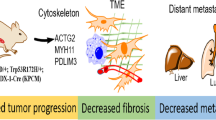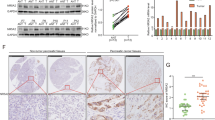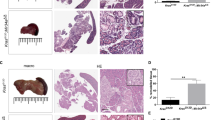Abstract
Pancreatic cancer (PC) is characterized by aberrant overexpression of mucins that contribute to its pathogenesis. Although the inflammatory cytokines contribute to mucin overexpression, the mucin profile of PC is markedly distinct from that of normal or inflamed pancreas. We postulated that de novo expression of various mucins in PC involves chromatin modifications. Analysis of chromatin modifying enzymes by PCR array identified differential expression of NCOA3 in MUC4-expressing PC cell lines. Immunohistochemistry analysis in tumor tissues from patients and spontaneous mouse models, and microarray analysis following the knockdown of NCOA3 were performed to elucidate its role in mucin regulation and overall impact on PC. Silencing of NCOA3 in PC cell lines resulted in significant downregulation of two most differentially expressed mucins in PC, MUC4 and MUC1 (P<0.01). Immunohistochemistry analysis in PC tissues and metastatic lesions established an association between NCOA3 and mucin (MUC1 and MUC4) expression. Spontaneous mouse model of PC (K-rasG12D; Pdx-1cre) showed early expression of Ncoa3 during pre-neoplastic lesions. Mechanistically, NCOA3 knockdown abrogated retinoic acid-mediated MUC4 upregulation by restricting MUC4 promoter accessibility as demonstrated by micrococcus nuclease digestion (P<0.05) and chromatin immuno-precipitation analysis. NCOA3 also created pro-inflammatory conditions by upregulating chemokines like CXCL1, 2, 5 and CCL20 (P<0.001). AKT, ubiquitin C, ERK1/2 and NF-κB occupied dominant nodes in the networks significantly modulated after NCOA3 silencing. In addition, NCOA3 stabilized mucins post translationally through fucosylation by FUT8, as the knockdown of FUT8 resulted in the downregulation of MUC4 and MUC1 at protein levels.
This is a preview of subscription content, access via your institution
Access options
Subscribe to this journal
Receive 50 print issues and online access
$259.00 per year
only $5.18 per issue
Buy this article
- Purchase on Springer Link
- Instant access to full article PDF
Prices may be subject to local taxes which are calculated during checkout






Similar content being viewed by others
References
Hollingsworth MA, Strawhecker JM, Caffrey TC, Mack DR . Expression of MUC1, MUC2, MUC3 and MUC4 mucin mRNAs in human pancreatic and intestinal tumor cell lines. Int J Cancer 1994; 57: 198–203.
Hollingsworth MA, Swanson BJ . Mucins in cancer: protection and control of the cell surface. Nat Rev Cancer 2004; 4: 45–60.
Braat H, Bruno M, Kuipers EJ, Peppelenbosch MP . Pancreatic cancer: promise for personalised medicine? Cancer Lett 2012; 318: 1–8.
Jemal A, Siegel R, Ward E, Murray T, Xu J, Thun MJ . Cancer statistics, 2007. CA Cancer J Clin 2007; 57: 43–66.
Chaturvedi P, Singh AP, Chakraborty S, Chauhan SC, Bafna S, Meza JL et al. MUC4 mucin interacts with and stabilizes the HER2 oncoprotein in human pancreatic cancer cells. Cancer Res 2008; 68: 2065–2070.
Saitou M, Goto M, Horinouchi M, Tamada S, Nagata K, Hamada T et al. MUC4 expression is a novel prognostic factor in patients with invasive ductal carcinoma of the pancreas. J Clin Pathol 2005; 58: 845–852.
Swartz MJ, Batra SK, Varshney GC, Hollingsworth MA, Yeo CJ, Cameron JL et al. MUC4 expression increases progressively in pancreatic intraepithelial neoplasia. Am J Clin Pathol 2002; 117: 791–796.
Andrianifahanana M, Moniaux N, Schmied BM, Ringel J, Friess H, Hollingsworth MA et al. Mucin (MUC) gene expression in human pancreatic adenocarcinoma and chronic pancreatitis: a potential role of MUC4 as a tumor marker of diagnostic significance. Clin Cancer Res 2001; 7: 4033–4040.
Kawano T, Ahmad R, Nogi H, Agata N, Anderson K, Kufe D . MUC1 oncoprotein promotes growth and survival of human multiple myeloma cells. Int J Oncol 2008; 33: 153–159.
Carson DD . The cytoplasmic tail of MUC1: a very busy place. Sci Signal 2008; 1: e35.
Haridas D, Chakraborty S, Ponnusamy MP, Lakshmanan I, Rachagani S, Cruz E et al. Pathobiological implications of MUC16 expression in pancreatic cancer. PLoS One 2011; 6: e26839.
Borchers MT, Carty MP, Leikauf GD . Regulation of human airway mucins by acrolein and inflammatory mediators. Am J Physiol 1999; 276: L549–L555.
Koo JS, Kim YD, Jetten AM, Belloni P, Nettesheim P . Overexpression of mucin genes induced by interleukin-1 beta, tumor necrosis factor-alpha, lipopolysaccharide, and neutrophil elastase is inhibited by a retinoic acid receptor alpha antagonist. Exp Lung Res 2002; 28: 315–332.
Li X, Wang L, Nunes DP, Troxler RF, Offner GD . Pro-inflammatory cytokines up-regulate MUC1 gene expression in oral epithelial cells. J Dent Res 2003; 82: 883–887.
Andrianifahanana M, Agrawal A, Singh AP, Moniaux N, van SI, Aubert JP et al. Synergistic induction of the MUC4 mucin gene by interferon-gamma and retinoic acid in human pancreatic tumour cells involves a reprogramming of signalling pathways. Oncogene 2005; 24: 6143–6154.
Chen H, Lin RJ, Schiltz RL, Chakravarti D, Nash A, Nagy L et al. Nuclear receptor coactivator ACTR is a novel histone acetyltransferase and forms a multimeric activation complex with P/CAF and CBP/p300. Cell 1997; 90: 569–580.
Li H, Gomes PJ, Chen JD . RAC3 a steroid/nuclear receptor-associated coactivator that is related to SRC-1 and TIF2. Proc Natl Acad Sci USA 1997; 94: 8479–8484.
Reid G, Gallais R, Metivier R . Marking time: the dynamic role of chromatin and covalent modification in transcription. Int J Biochem Cell Biol 2009; 41: 155–163.
Xu J, Wu RC, O'Malley BW . Normal and cancer-related functions of the p160 steroid receptor co-activator (SRC) family. Nat Rev Cancer 2009; 9: 615–630.
Dharmaraj N, Wang P, Carson DD . Cytokine and progesterone receptor interplay in the regulation of MUC1 gene expression. Mol Endocrinol 2010; 24: 2253–2266.
Hingorani SR, Petricoin EF, Maitra A, Rajapakse V, King C, Jacobetz MA et al. Preinvasive and invasive ductal pancreatic cancer and its early detection in the mouse. Cancer Cell 2003; 4: 437–450.
Rachagani S, Torres MP, Kumar S, Haridas D, Baine M, Macha MA et al. Mucin (Muc) expression during pancreatic cancer progression in spontaneous mouse model: potential implications for diagnosis and therapy. J Hematol Oncol 2012; 5: 68.
Brown K, Chen Y, Underhill TM, Mymryk JS, Torchia J . The coactivator p/CIP/SRC-3 facilitates retinoic acid receptor signaling via recruitment of GCN5. J Biol Chem 2003; 278: 39402–39412.
Nakles RE, Shiffert MT, Diaz-Cruz ES, Cabrera MC, Alotaiby M, Miermont AM et al. Altered AIB1 or AIB1Delta3 expression impacts ERalpha effects on mammary gland stromal and epithelial content. Mol Endocrinol 2011; 25: 549–563.
Hawker NP, Pennypacker SD, Chang SM, Bikle DD . Regulation of human epidermal keratinocyte differentiation by the vitamin D receptor and its coactivators DRIP205, SRC2, and SRC3. J Invest Dermatol 2007; 127: 874–880.
Grzesiak JJ, Ho JC, Moossa AR, Bouvet M . The integrin-extracellular matrix axis in pancreatic cancer. Pancreas 2007; 35: 293–301.
McAllister F, Bailey JM, Alsina J, Nirschl CJ, Sharma R, Fan H et al. Oncogenic Kras activates a hematopoietic-to-epithelial IL-17 signaling axis in preinvasive pancreatic neoplasia. Cancer Cell 2014; 25: 621–637.
McCarroll JA, Phillips PA, Santucci N, Pirola RC, Wilson JS, Apte MV . Vitamin A inhibits pancreatic stellate cell activation: implications for treatment of pancreatic fibrosis. Gut 2006; 55: 79–89.
Rieder S, Michalski CW, Friess H, Kleeff J . Insulin-like growth factor signaling as a therapeutic target in pancreatic cancer. Anticancer Agents Med Chem 2011; 11: 427–433.
Percharde M, Azuara V . Essential roles for the nuclear receptor coactivator Ncoa3 in pluripotency. Cell Cycle 2013; 12: 195–196.
Al-Otaiby M, Tassi E, Schmidt MO, Chien CD, Baker T, Salas AG et al. Role of the nuclear receptor coactivator AIB1/SRC-3 in angiogenesis and wound healing. Am J Pathol 2012; 180: 1474–1484.
York B, Yu C, Sagen JV, Liu Z, Nikolai BC, Wu RC et al. Reprogramming the posttranslational code of SRC-3 confers a switch in mammalian systems biology. Proc Natl Acad Sci USA 2010; 107: 11122–11127.
Li J, Niu J, Ou S, Ye ZY, Liu DQ, Wang FC et al. Effects of SCR-3 on the immunosuppression accompanied with the systemic inflammatory response syndrome. Mol Cell Biochem 2012; 364: 29–37.
Bautista S, Valles H, Walker RL, Anzick S, Zeillinger R, Meltzer P et al. In breast cancer, amplification of the steroid receptor coactivator gene AIB1 is correlated with estrogen and progesterone receptor positivity. Clin Cancer Res 1998; 4: 2925–2929.
Li Z, Fang ZY, Ding Y, Yao WT, Yang Y, Zhu ZQ et al. Amplifications of NCOA3 gene in colorectal cancers in a Chinese population. World J Gastroenterol 2012; 18: 855–860.
Ghadimi BM, Schrock E, Walker RL, Wangsa D, Jauho A, Meltzer PS et al. Specific chromosomal aberrations and amplification of the AIB1 nuclear receptor coactivator gene in pancreatic carcinomas. Am J Pathol 1999; 154: 525–536.
Henke RT, Haddad BR, Kim SE, Rone JD, Mani A, Jessup JM et al. Overexpression of the nuclear receptor coactivator AIB1 (SRC-3) during progression of pancreatic adenocarcinoma. Clin Cancer Res 2004; 10: 6134–6142.
Harigopal M, Heymann J, Ghosh S, Anagnostou V, Camp RL, Rimm DL . Estrogen receptor co-activator (AIB1) protein expression by automated quantitative analysis (AQUA) in a breast cancer tissue microarray and association with patient outcome. Breast Cancer Res Treat 2009; 115: 77–85.
Zhao C, Yasui K, Lee CJ, Kurioka H, Hosokawa Y, Oka T et al. Elevated expression levels of NCOA3, TOP1, and TFAP2C in breast tumors as predictors of poor prognosis. Cancer 2003; 98: 18–23.
Kuang SQ, Liao L, Zhang H, Lee AV, O'Malley BW, Xu J . AIB1/SRC-3 deficiency affects insulin-like growth factor I signaling pathway and suppresses v-Ha-ras-induced breast cancer initiation and progression in mice. Cancer Res 2004; 64: 1875–1885.
Ling J, Kang Y, Zhao R, Xia Q, Lee DF, Chang Z et al. KrasG12D-induced IKK2/beta/NF-kappaB activation by IL-1alpha and p62 feedforward loops is required for development of pancreatic ductal adenocarcinoma. Cancer Cell 2012; 21: 105–120.
Barry-Hamilton V, Spangler R, Marshall D, McCauley S, Rodriguez HM, Oyasu M et al. Allosteric inhibition of lysyl oxidase-like-2 impedes the development of a pathologic microenvironment. Nat Med 2010; 16: 1009–1017.
Mejias-Luque R, Linden SK, Garrido M, Tye H, Najdovska M, Jenkins BJ et al. Inflammation modulates the expression of the intestinal mucins MUC2 and MUC4 in gastric tumors. Oncogene 2010; 29: 1753–1762.
Yu C, York B, Wang S, Feng Q, Xu J, O'Malley BW . An essential function of the SRC-3 coactivator in suppression of cytokine mRNA translation and inflammatory response. Mol Cell 2007; 25: 765–778.
Okuyama N, Ide Y, Nakano M, Nakagawa T, Yamanaka K, Moriwaki K et al. Fucosylated haptoglobin is a novel marker for pancreatic cancer: a detailed analysis of the oligosaccharide structure and a possible mechanism for fucosylation. Int J Cancer 2006; 118: 2803–2808.
Navas C, Hernandez-Porras I, Schuhmacher AJ, Sibilia M, Guerra C, Barbacid M . EGF receptor signaling is essential for k-ras oncogene-driven pancreatic ductal adenocarcinoma. Cancer Cell 2012; 22: 318–330.
Fereshteh MP, Tilli MT, Kim SE, Xu J, O'Malley BW, Wellstein A et al. The nuclear receptor coactivator amplified in breast cancer-1 is required for Neu (ErbB2/HER2) activation, signaling, and mammary tumorigenesis in mice. Cancer Res 2008; 68: 3697–3706.
Lahusen T, Fereshteh M, Oh A, Wellstein A, Riegel AT . Epidermal growth factor receptor tyrosine phosphorylation and signaling controlled by a nuclear receptor coactivator, amplified in breast cancer 1. Cancer Res 2007; 67: 7256–7265.
Lin H, Wang D, Wu T, Dong C, Shen N, Sun Y et al. Blocking core fucosylation of TGF-beta1 receptors downregulates their functions and attenuates the epithelial-mesenchymal transition of renal tubular cells. Am J Physiol Renal Physiol 2011; 300: F1017–F1025.
Liu YC, Yen HY, Chen CY, Chen CH, Cheng PF, Juan YH et al. Sialylation and fucosylation of epidermal growth factor receptor suppress its dimerization and activation in lung cancer cells. Proc Natl Acad Sci USA 2011; 108: 11332–11337.
Wang Y, Lonard DM, Yu Y, Chow DC, Palzkill TG, O'Malley BW . Small molecule inhibition of the steroid receptor coactivators, SRC-3 and SRC-1. Mol Endocrinol 2011; 25: 2041–2053.
Wang Y, Lonard DM, Yu Y, Chow DC, Palzkill TG, Wang J et al. Bufalin Is a potent small-molecule inhibitor of the steroid receptor coactivators SRC-3 and SRC-1. Cancer Res 2014; 74: 1506–1517.
Moniaux N, Chakraborty S, Yalniz M, Gonzalez J, Shostrom VK, Standop J et al. Early diagnosis of pancreatic cancer: neutrophil gelatinase-associated lipocalin as a marker of pancreatic intraepithelial neoplasia. Br J Cancer 2008; 98: 1540–1547.
Livak KJ, Schmittgen TD . Analysis of relative gene expression data using real-time quantitative PCR and the 2(-Delta Delta C(T)) Method. Methods 2001; 25: 402–408.
Singh AP, Moniaux N, Chauhan SC, Meza JL, Batra SK . Inhibition of MUC4 expression suppresses pancreatic tumor cell growth and metastasis. Cancer Res 2004; 64: 622–630.
Chakraborty S, Swanson BJ, Bonthu N, Batra SK . Aberrant upregulation of MUC4 mucin expression in cutaneous condyloma acuminatum and squamous cell carcinoma suggests a potential role in the diagnosis and therapy of skin diseases. J Clin Pathol 2010; 63: 579–584.
Dey P, Ponnusamy MP, Deb S, Batra SK . Human RNA polymerase II-association factor 1 (hPaf1/PD2) regulates histone methylation and chromatin remodeling in pancreatic cancer. PLoS One 2011; 6: e26926.
Acknowledgements
We thank Lynette Smith, Dr Joshua Souchek, Ms Kavita Mallya, Dr Neeru Sharma and Dr Parama Dey for help in statistical analysis and technical support. Microarray analysis was performed using BRB-Array Tools developed by Dr. Richard Simon and BRB-Array Development Team. The work was supported, in parts, by grants from the NIH (TMEN U54 CA163120, RO1 CA183459, EDRN UO1, CA111294, SPORE P50 CA127297 and RO3 CA167342).
Author Contributions
SK, SKB, SD designed the study. SK, SD, SR, S Kaur, SJ performed experiments, analyzed the data and wrote the manuscript. S Kaur performed MUC4 IHC and PMP performed NCOA3 chromatin immuno-precipitation. SR performed the animal experiments and SLJ analyzed the pathological samples. SK, MJ, SKB were involved in manuscript preparation and data analysis.
Author information
Authors and Affiliations
Corresponding author
Ethics declarations
Competing interests
The authors declare no conflict of interest.
Additional information
Supplementary Information accompanies this paper on the Oncogene website
Supplementary information
Rights and permissions
About this article
Cite this article
Kumar, S., Das, S., Rachagani, S. et al. NCOA3-mediated upregulation of mucin expression via transcriptional and post-translational changes during the development of pancreatic cancer. Oncogene 34, 4879–4889 (2015). https://doi.org/10.1038/onc.2014.409
Received:
Revised:
Accepted:
Published:
Issue Date:
DOI: https://doi.org/10.1038/onc.2014.409



